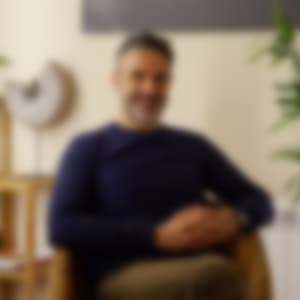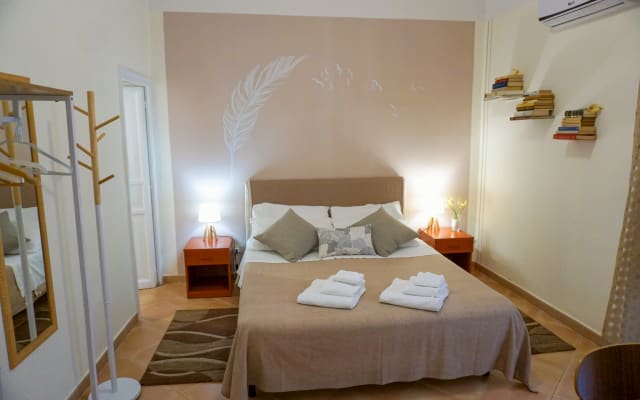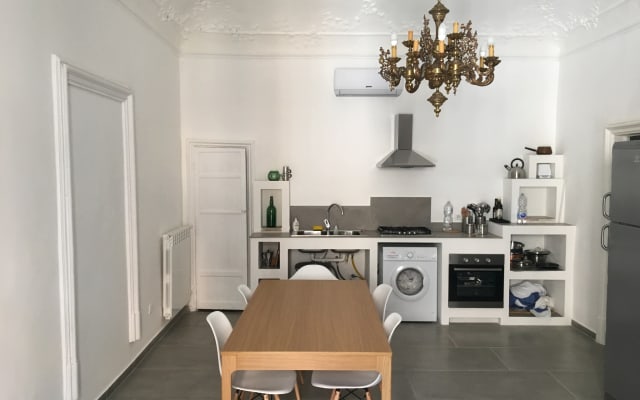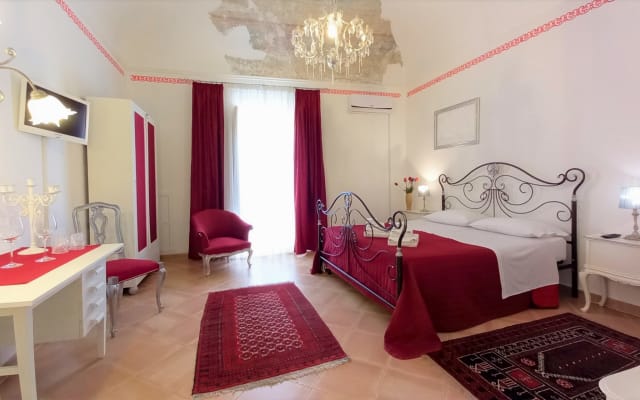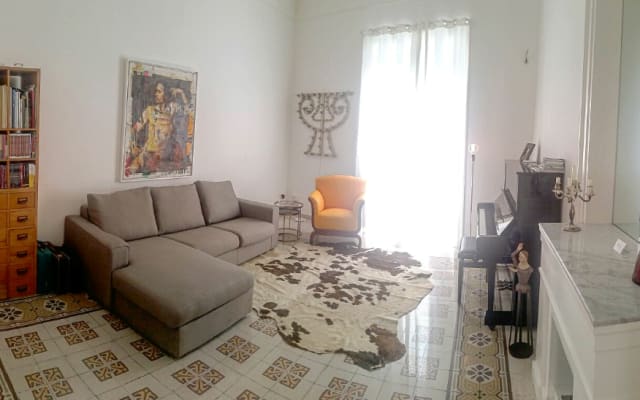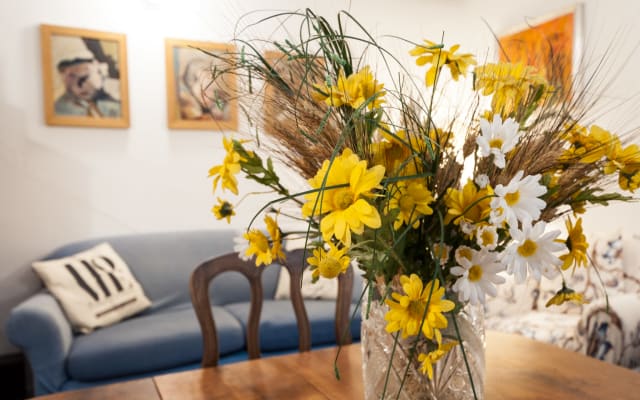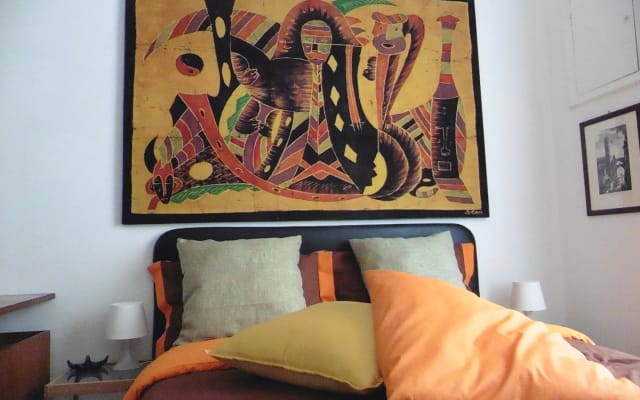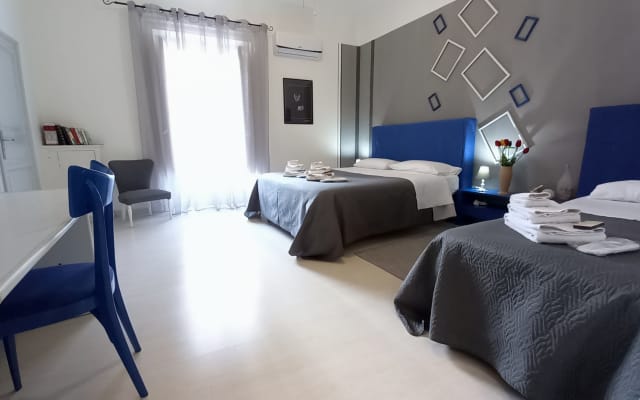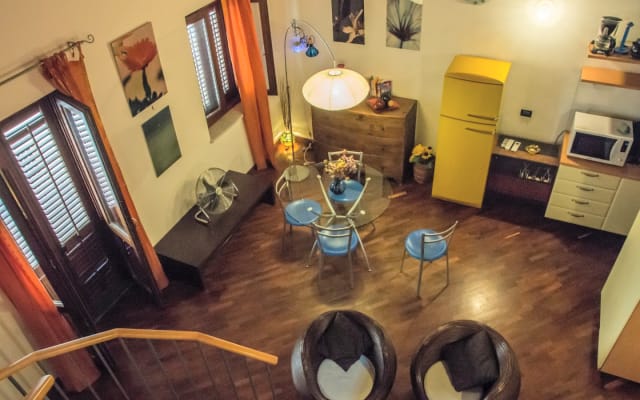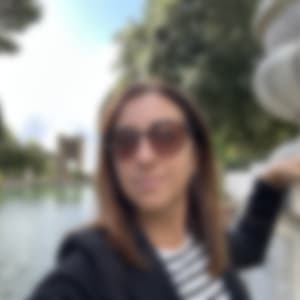Premier Apartment
-
Entire place
-
5 guests
-
2 bedrooms
-
1 bathroom
-
3 beds
- Host shares gay local tips
- LGBTQ+ venues nearby
- Wi-Fi
Why book with misterb&b?
About the Place Initially in English, this text was translated via a machine translation service and may contain inaccuracies or errors.
Al vicolo B&B is just opposite the entrance of the historical Ballaro’ market, one of the most peculiar markets in Palermo. It is also close to the central station, from where all main connections to the rest of the island leave.
Al vicolo B&B is just opposite the entrance of the historical Ballaro’ market, one of the most peculiar markets in Palermo. It is also close to the central station, from where all main connections to the rest of the island leave.
Amenities
- Host shares gay local tips
- LGBTQ+ venues nearby
- Wi-Fi
- Air conditioning
- Kitchen
- Heating
- TV
- Essentials
- Hair dryer
Nearby Attractions Initially in English, this text was translated via a machine translation service and may contain inaccuracies or errors.
Visiting Palermo means immersing in the deepest heart of the Mediterranean culture. In this sunny land, numerous cultures followed one another, deeply marking the architectural and monumental structure, and above all, creating a cultural, richly evocative chemistry. In Palermo we can admire many buildings that still today show the many influences to which the city has been exposed to in the past centuries.
For other Tourist Information ********
_____________________________________________________________________
Among its most significant monuments Palermo note:
• the Teatro Politeama Garibaldi, the first, chronologically, of the great theatres that rose in the second half of the 19th Century. Profoundly innovating the theatrical typology and its building techniques, the Politeama was the result of a particular attention towards Hellenism and polychromic Greek and Roman architecture, probed and studied first in Pompei and Ercolano and then in Sicily, in Selinute and Agrigento. The result is a rare example of the Italian architectural scenario of the second half of the 19th Century, where technologic vanguard, complexity and elegance find their way, with its iron structures, along with an artistic experience derived from the interpretation of Greek-Sicilian forms, brought back to a refined polychromy.
• the Teatro Massimo Vittorio Emanuele of Palermo opened its doors to the public on the evening of the 16th May 1897. Second theatre in Europe (second only to the Opera de Paris), is one of the biggest in the world and can contain up to 1,300 people. An imposing neoclassic building introduced by a triangular pediment on six columns which recreate the pronaos of a temple. To the side, a wide dome resting on a high tambour. Started in 1875 by Giovanni Battista Basile and then finished by his son Ernesto, who also planned the two characteristic liberty kiosks opposite the theatre.
• the Quattro Canti (Four Corners). At the intersection of two of Palermo’s main streets is a wide stretch, at the four corners of which rise the convex façades of the beautiful 17th Century mansions with the classic division of the three laid upon orders (Doric, Ionic and Corinthian) with, in the middle, fountains surmounted by statues representing the four seasons. In the nichel of the superior orders are statues of Spanish Kings and, at a higher level, those of the Saint Patrons of Palermo, Saints Christine, Nymph, Olive and Agata, later replaced with Saint Rosalie. The crossing also marks the four areas in which Palermo was split: Palazzo Reale, Mezzomonreale, Castellammare and Oreto, each of which is entrusted to the Patron Saints.
• Chiesa della Magione (Church of the Magione), built in 1191 for the Cistercian monks, and severely damaged by bombing, was later restored and partially rebuilt. Access is through a Baroque portal. Inside is a nave with two side aisles on marble columns and pointed arches. On the floor are tombstones of Teutonic knights. Among the work of arts in its interior are: two stoups at each side of the entrance, and a Virgin with the Infant Jesus, all of the 16th Century. In the left apse is a shrine of the 16th Century and a Virgin painted on board, probably of the 15th Century.
• the Palazzo dei Normanni (Palace of Normans), also known as Palazzo Reale (Royal Palace), which presently hosts the Seat of the Region, preserves in its interior the most significant monument of the Arabian-Norman art, the Palatine Chapel, erected by King Ruggero II in the 12th Century and entirely covered with sparkling golden mosaics and inlays.
• the Chiesa di San Giovanni degli Eremiti (Church of St. John of the hermits), erected on the ruins of a pre-existing religious building in the 12th Century, is one of the most significant examples of the Arabian presence in Palermo, and this is especially recognisable in the red domes and in the numerous ogival arches that decorate the interior of the church.
• the Cathedral is of exhilarating magnificence, with its needleful towers, twin lancet windows, interwoven and ogival arches. Built in 1184, it keeps its original structure, despite the alterations that followed with the Centuries, the main one carried out in the 18th Century, with the addition of side aisles and of the Baroque dome.
• the Martorana, (S.Maria dell'Ammiraglio). According to the Arabian traveller Ibn Giubair this is "the most beautiful monument of the world”. Built in 1143, owes its name to the fact the during the Aragonese age was given to the monastery founded by Eloisa Martorana. Among the magnificent golden mosaics that completely cover its walls is King Ruggero II, crowned by Christ, and George of Antiochia at the feet of the Virgin. Also beautiful is the four-level bell tower, decorated with twin lancet windows, small columns and golden tarsia, mosaic inlaid wood. Of importance is also the Arab-Norman bell tower.
• Palazzo Abatellis, built in the 15th Century, currently hosting the Galleria Nazionale di Sicilia (National Gallery of Sicily), in which highly valuable works of art by Sicilian artists are preserved, among which are Antonello da Messina (15th Century) and Francesco Laurana (15th Century).
• the Castello della Zisa, (The Zisa Castle), 12th Century, dates back to the Norman domination period in Sicily. The construction began under the reign of William I and ended under the reign of William II. The Zisa was originally a summer residence, built in the vicinity of the city for the king’s relaxation and amusement. The name Zisa probably comes from the Arabic al-Ays, meaning noble, glorious, magnificent.
• the Parco della Favorita, is one of Palermo’s public gardens, once shooting ground of King Ferdinand IV. It is enriched with a few buildings in which cultural and social activities take place.
Visiting Palermo means immersing in the deepest heart of the Mediterranean culture. In this sunny land, numerous cultures followed one another, deeply marking the architectural and monumental structure, and above all, creating a cultural, richly evocative chemistry. In Palermo we can admire many ...
read moreAbout the Host
Property Rules Initially in English, this text was translated via a machine translation service and may contain inaccuracies or errors.
the air conditioning service is not included in the price. the cost is 10 euros per day. We can provide you with the necessary for an Italian breakfast as these are all packaged: plum cakes, rusks, butter, jams, hazelnut cream, milk, tea, orange juice, coffee, water. The price is € 3.50 per person per day, it must be booked before your arrival.
Pets are accepted only by prior arrangement and at a cost of more than € 30 for final cleaning
the air conditioning service is not included in the price. the cost is 10 euros per day. We can provide you with the necessary for an Italian breakfast as these are all packaged: plum cakes, rusks, butter, jams, hazelnut cream, milk, tea, orange j...
read moreConditions
Cancellation Policy


You can contact Ferdinando through the Contact Host button on this page. If you've already booked, go to My trips.
Travel with peace of mind while connecting with the gay community. As the largest gay hotelier in the world, misterb&b guarantees secure payments, Booking insurance Coverage, and a customer support team that is at your service.
It is up to the host to ask for a security deposit. If there is a security deposit on the listing, the amount is displayed underneath the price per night.
A confirmation e-mail with the contact information of your host will be sent to your e-mail address upon a successful booking. Log in to your misterb&b account and visit My trips. Here you will find the status and details of all your bookings and booking requests.
More about gay Palermo










